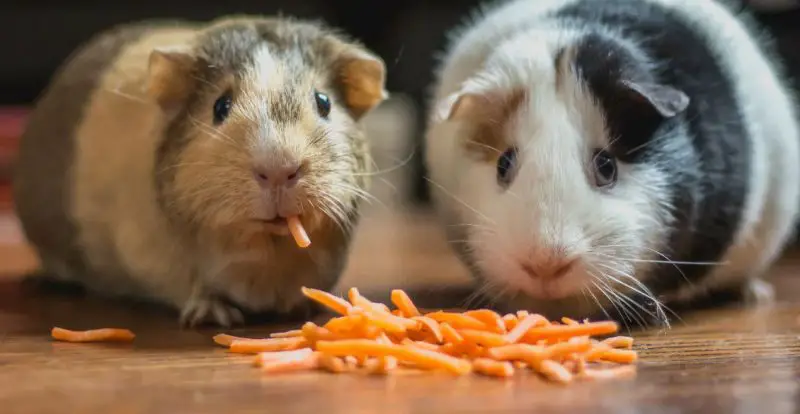Guinea pigs are gentle, expressive and highly social pets known for their chirps, squeaks and adorably round bodies. Their diet plays a central role in their health, influencing their digestion, energy levels, immunity and lifespan. Understanding what guinea pigs eat is essential for anyone who wants to keep these animals thriving, whether they live indoors, outdoors or in a mixed environment. While guinea pigs may seem simple to feed, their nutritional needs are surprisingly specific.
A guinea pig’s natural diet relies heavily on plant materials. They evolved in the grassy plains and dry climates of South America, where they fed on a variety of grasses and leafy vegetation. This environment shaped their digestive system into one that requires high fiber, low fat and consistent roughage. Their bodies also cannot synthesize vitamin C, making dietary sources essential to prevent deficiencies like scurvy.
This guide explores 20 foods guinea pigs love most, offering a detailed look at their nutritional value, feeding behavior and role in a balanced diet. Whether you’re a new owner or an experienced caretaker, understanding these foods will help you support your guinea pig’s long-term well-being.
Understanding the Guinea Pig Diet

Guinea pigs have a specialized digestive system built for processing fibrous plants. Their teeth grow continuously throughout life, meaning they must chew rough foods to keep them worn down. Diets lacking fiber can lead to dental overgrowth, digestive issues and serious health complications. Hay is therefore the foundation of a guinea pig’s diet, providing both fiber and dental benefits.
Vegetables, fruits and herbs supplement the diet by providing vitamins, hydration and variety. Vitamin C is particularly critical, as guinea pigs cannot produce it naturally. Without enough vitamin C, guinea pigs can experience weakness, lethargy and joint problems. Balanced meals prevent deficiencies and support active, curious behavior.
Guinea pigs are grazers that prefer small, frequent meals. In the wild, they constantly nibble on available grasses. As pets, they require similar access to hay, fresh greens and occasional treats. The foods listed below highlight what guinea pigs naturally gravitate toward and how each type contributes to their health.
20 Foods Guinea Pigs Love Most
1. Timothy Hay
Timothy hay is the foundational food in every guinea pig diet. Its long, coarse strands are packed with fiber that keeps the digestive system functioning properly and prevents dangerous conditions like gastrointestinal stasis. This type of hay also offers the ideal balance of roughness and nutrition for daily grazing.
Guinea pigs spend many hours each day nibbling timothy hay, mimicking the natural grazing patterns of their wild ancestors. This constant chewing action helps regulate digestion, minimizing gas buildup and supporting a healthy gut microbiome. The mild, grassy aroma encourages even picky guinea pigs to eat consistently.
Perhaps most importantly, timothy hay keeps teeth at a healthy length. Since guinea pig teeth grow continuously, the abrasive texture of this hay naturally files them down, preventing painful overgrowth and dental issues. For all these reasons, timothy hay must be available at all times.
2. Orchard Grass
Orchard grass provides a softer, sweeter alternative that many guinea pigs love. Its gentle texture makes it easier to chew, especially for young guinea pigs with sensitive teeth or older guinea pigs experiencing mild dental wear. Owners often notice guinea pigs diving into orchard grass eagerly due to its inviting aroma.
This grass maintains high fiber content, helping regulate digestion and maintain healthy stool formation. It is slightly more flexible than timothy hay, offering a more tender bite without sacrificing nutritional value. Many guinea pigs appreciate the change of texture when orchard grass is mixed into their hay pile.
Offering orchard grass alongside timothy hay encourages natural foraging instincts. The combination provides enrichment and variety, making daily meals more interesting and satisfying for the animals.
3. Meadow Hay
Meadow hay contains a diverse mixture of grasses, wildflowers and herbs, mimicking the varied vegetation guinea pigs would encounter in their natural environment. Its blend introduces different textures, flavors and plant compounds that stimulate curiosity and enrich the feeding experience.
The mix typically includes ryegrass, clover, timothy and assorted meadow herbs depending on the region where it’s harvested. This natural variety encourages guinea pigs to explore and select preferred strands, keeping them mentally engaged and physically active.
Meadow hay not only supports digestive health but also introduces small amounts of natural minerals and phytonutrients. Rotating it with other hay types helps diversify the diet while maintaining necessary fiber.
4. Romaine Lettuce
Romaine lettuce is a top choice among leafy greens due to its excellent nutrient profile and high hydration content. It provides vitamin A for eye and immune health, while its crisp texture encourages enthusiastic eating.
Guinea pigs enjoy the satisfying crunch of romaine, which mentally stimulates them during feeding. Unlike iceberg lettuce, romaine contains significantly more nutrients and avoids the risk of overly watery intake, ensuring safer digestion.
Offering romaine several times per week adds moisture and essential vitamins to the diet without overwhelming the digestive system. It is ideal as a base green for vegetable mixes.
5. Green Leaf Lettuce
Green leaf lettuce is gentle on the stomach and offers a softer texture that many guinea pigs find pleasant. Its leafy structure allows guinea pigs to tear pieces easily, making it accessible to pigs of all ages.
This lettuce provides hydration and fiber while remaining low in calcium and sugar, making it a reliable daily choice. Its mild flavor appeals even to guinea pigs that are hesitant about new vegetables.
Green leaf lettuce helps diversify greens while balancing out stronger, nutrient-dense vegetables. It gives guinea pigs a safe, refreshing option throughout the week.
6. Bell Peppers
Bell peppers are among the most valuable vegetables for guinea pigs due to their exceptionally high vitamin C content. Since guinea pigs cannot synthesize vitamin C, bell peppers become one of the primary ways to prevent deficiencies.
Red and yellow peppers provide natural sweetness and are usually the most beloved, while green peppers offer a crisper, less sugary bite. All varieties are packed with antioxidants, fiber and moisture.
Incorporating bell peppers regularly helps strengthen immunity, support collagen production in joints and maintain vibrant energy levels.
7. Carrots
Carrots are a favorite treat because of their sweet flavor and crunchy texture. Guinea pigs enjoy the satisfying resistance of chewing carrot sticks, which helps naturally file their teeth.
These vivid root vegetables provide beta-carotene, which converts to vitamin A and supports skin and eye health. They also add variety to vegetable rotations, keeping meals exciting.
However, due to their natural sugar content, carrots should be offered sparingly. Occasional slices make excellent treats without affecting dietary balance.
8. Cilantro
Cilantro is a fragrant herb with soft leaves that guinea pigs love. Its refreshing aroma often encourages even nervous or picky guinea pigs to try new foods when mixed with greens.
This herb contains antioxidants and mild vitamin C levels. The soft texture makes it gentle on the mouth and stomach, suitable for frequent feeding in rotation with other herbs.
Cilantro is ideal as a flavor enhancer within vegetable bowls, providing both taste and nutritional benefits.
9. Parsley
Parsley is one of the richest natural sources of vitamin C available to guinea pigs. Its bold, slightly peppery flavor appeals to many pigs, making it a strong favorite.
Since parsley contains higher levels of calcium, it should be used strategically. Small servings a few times a week provide excellent nutritional boosts without risking calcium imbalance.
When used correctly, parsley strengthens immunity and supports overall vitality, especially during cooler months.
10. Spinach
Spinach is a nutrient-dense leafy green that provides vitamins A, C and K. Its soft, smooth leaves are easy for guinea pigs to chew and digest.
Guinea pigs typically enjoy spinach’s earthy flavor, but it should be given sparingly due to high oxalate levels, which can contribute to urinary issues if fed excessively.
Even occasional servings of spinach add depth to the diet and support a broad range of nutritional needs.
11. Kale
Kale is rich in vitamins A, C and K, making it a powerful nutritional addition when offered in small portions. Its sturdy texture provides excellent chewing enrichment.
While many guinea pigs enjoy kale’s strong flavor, it should be balanced with lighter greens because of its calcium content. Rotating kale with romaine or lettuce helps prevent dietary imbalance.
Used wisely, kale contributes to immune function and healthy development.
12. Apples
Apples are refreshing, sweet treats that encourage playful feeding behavior. Guinea pigs love gnawing on crisp apple slices, which also help stimulate their teeth.
These fruits supply hydration and antioxidants but contain natural sugars, requiring careful portion control. A thin slice once or twice a week is ideal.
Removing seeds is important, as they may contain compounds unsafe for small animals.
13. Blueberries
Blueberries are nutrient-packed berries loaded with antioxidants beneficial for guinea pig immunity. Their soft skins and juicy pulp make them easy to chew.
Despite their size, blueberries are sugary and should be fed sparingly—one or two berries at a time. Their bright flavor often encourages guinea pigs to try new fruits or vegetables.
Blueberries add color and excitement to occasional treat schedules.
14. Strawberries
Strawberries are another hydrating, vitamin C-rich fruit guinea pigs enjoy. Their vibrant aroma and sweet taste usually make them a hit.
Their sugar content means they should be reserved as occasional treats, sliced into small portions to avoid overconsumption. Many guinea pigs love nibbling on the soft flesh.
Strawberries add dietary variety and help with hydration, especially in warmer seasons.
15. Cucumber
Cucumber is extremely hydrating and refreshing, making it an excellent hot-weather treat. Guinea pigs enjoy the cool, crisp texture and mild taste.
While cucumbers contain fewer nutrients than leafy greens, they provide valuable moisture, especially for guinea pigs reluctant to drink water. Thin slices or small chunks work best.
Cucumber should be used as a supplement to complete vegetable mixes, not as a primary green.
16. Zucchini
Zucchini offers hydration, fiber and a smooth texture that guinea pigs find easy to chew. It is low in calcium and sugar, making it safe for regular feeding.
Many guinea pigs accept zucchini readily, and its neutral flavor blends well with other vegetables. Its soft flesh is gentle on older guinea pigs’ teeth.
Zucchini is ideal for balancing out stronger vegetables and maintaining digestive comfort.
17. Tomatoes
Tomatoes are tasty and hydrating, offering vitamins A and C. Guinea pigs particularly enjoy cherry tomatoes, which are easy to grasp and bite into.
Only the ripe flesh should be fed—never the leaves or stems. Tomatoes must be given in moderation because of their acidity and sugar levels.
Occasional tomato wedges brighten up the diet and support hydration.
18. Broccoli
Broccoli provides fiber, vitamin C and valuable antioxidants. Guinea pigs can eat both florets and stems, giving them multiple textures to explore.
Due to its potential to cause gas, broccoli should be introduced slowly. Small portions help gauge each guinea pig’s tolerance and prevent discomfort.
Used occasionally, broccoli supports immune strength and digestive diversity.
19. Pellets (Fortified)
Pellets formulated specifically for guinea pigs contain essential nutrients missing from other foods, especially stabilized vitamin C. These pellets complement hay and vegetables rather than replacing them.
High-quality pellets are made from timothy hay for adult guinea pigs, supporting calcium balance and preventing urinary problems. Limiting serving sizes helps avoid weight gain.
Fortified pellets provide consistency and ensure that guinea pigs receive a balanced baseline of daily nutrition.
20. Fresh Grass
Fresh grass gives guinea pigs a natural grazing outlet, allowing them to behave much like they would in the wild. Its tender blades are easy to chew and provide fiber similar to hay.
Grass contains water, vitamins and minerals that support hydration and digestive stability. Letting guinea pigs graze outdoors stimulates natural exploration, but supervision is crucial to avoid harmful plants.
Fresh grass reconnects guinea pigs with instinctive feeding behavior and enriches their daily routine.
FAQs About What Do Guinea Pigs Eat
What do guinea pigs eat most?
High-fiber hay such as timothy hay forms the majority of their diet.
Do guinea pigs need vitamin C?
Yes. They cannot produce it and must get it from foods like bell peppers.
Can guinea pigs eat fruit?
Yes, but only in small portions due to natural sugars.
Do guinea pigs drink water?
They need fresh water available at all times.
Can guinea pigs eat alfalfa?
Only for young, pregnant or nursing guinea pigs. Adults should avoid excess calcium.
What vegetables are best?
Leafy greens like romaine, green leaf lettuce and cilantro are ideal.
How often should guinea pigs eat vegetables?
Daily, but in varied and rotating selections.
Are pellets mandatory?
Pellets help ensure balanced nutrients but should not be overfed.
Can guinea pigs eat grass?
Yes, as long as it’s pesticide-free.
What foods should guinea pigs avoid?
Onions, potatoes, chocolate, iceberg lettuce and any processed foods.
Final Thoughts
Guinea pigs rely on a balanced diet rooted in fiber, fresh vegetables and safe hydration sources. Understanding what guinea pigs eat allows caretakers to support healthy digestion, proper dental wear and strong immunity. The 20 foods listed above not only nourish guinea pigs but also enrich their daily routines, encouraging natural grazing and offering sensory variety. With thoughtful feeding and consistent access to high-quality hay, guinea pigs can live long, active and happy lives.






